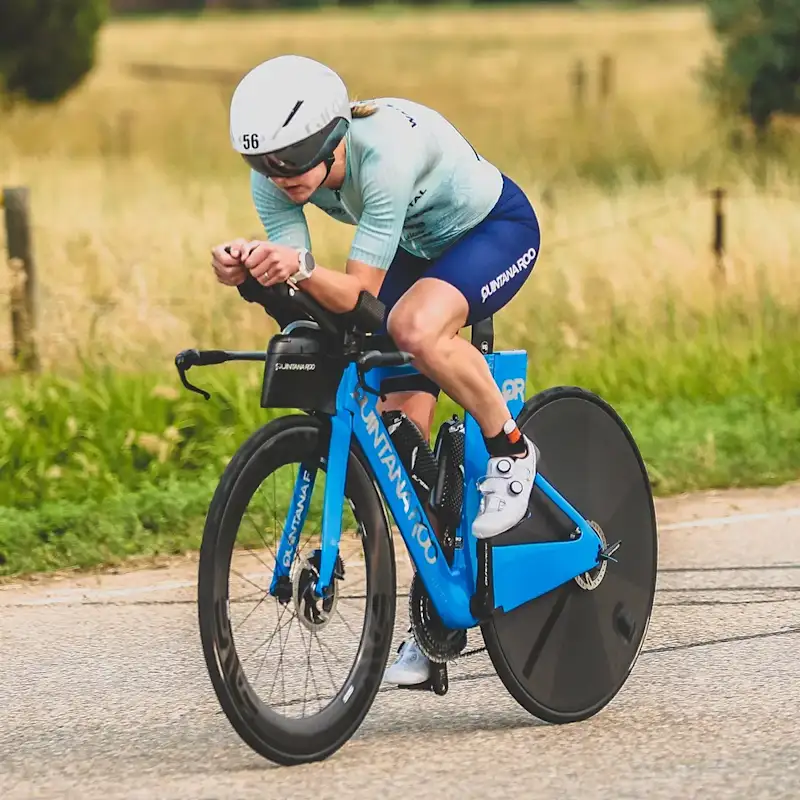
Jeanni Metzler
The Collins Cup
Jeanni's headline numbers
Jeanni's strategy
Fueling
Carbohydrate is the main fuel you burn when racing. Failing to fuel properly is a leading cause of underperformance in longer races.
Jeanni’s carb intake was well below the scientific recommendations, and since we know from IRONMAN 70.3® Boulder that she can comfortably consume over 75g/h, she should push to increase her intake closer to the current 90g/h recommendations. This will increase her carbohydrate availability, thus providing more energy for her to utilize whilst racing hard. Looking back, Jeanni believes the reason she didn’t fuel enough this time was because she drank less high-carb drinks, due to the cooler conditions not stimulating much thirst. This demonstrates a major drawback of not decoupling fuel and hydration, as it makes it more difficult to adapt your strategy to changes in the environment, like temperature. Recognising this for future races is a key takeaway for Jeanni, and she can be proactive by carrying more gels or chews.
Hydration
Taking on board an appropriate amount of fluid and sodium is essential to maintaining blood volume and supporting the cardiovascular effort needed to perform on race day.
Whilst the absolute amount of sodium and fluid consumed per hour is important, it’s critical to consider these in relation to each other. This is known as 'relative sodium concentration' and it’s expressed in milligrams per litre (mg/L). How much sodium you’re taking in per litre of fluid is more important than the absolute amount taken in per hour.
Sweat sodium concentration (mg/L) is largely genetically determined and remains relatively stable. Knowing how salty your sweat is enables you to replace a good proportion of your sweat losses, which can range from 200-2,000mg/L.
Given Jeanni’s losses are Very High (1,556mg/L), nailing her hydration strategy becomes especially crucial when it’s hot and/or humid.
Learn moreAlthough consuming PF Carb & Electrolyte Drink Mix pre-race contributed to her muscle and liver glycogen stores as well as delivering some electrolytes, Jeanni should consider instead consuming the higher strength PH 1500 to elevate blood plasma volume and optimize her pre-race hydration status. During the race, the relative sodium concentration of the fluids she drank was outside of her recommended intake, but due to the cooler conditions, Jeanni likely still replaced a decent proportion of her sweat losses. She did experience mild cramps on the run, but was able to push through them to finish the race.
Caffeine
Beyond the Three Levers of Performance (carb, sodium and fluid), caffeine is one of only a few substances that is proven to improve performance for most endurance athletes as it can help stave off mental and physical fatigue.
Estimating Jeanni’s body weight, she fell within the recommended dosage range for caffeine, and she’s used to incorporating the stimulant into her race plan through gels and chews. It worked well to help mask fatigue and deliver the ergogenic benefits we see with caffeine.
How Jeanni hit her numbers
Here's everything that Jeanni ate and drank on the day...
Jeanni's weapons of choice
Final thoughts
Jeanni's full stats
Data Confidence?
There is good confidence in the accuracy of the data reported. An athlete feels that the numbers closely reflect what they consumed despite a couple of estimations which may carry some degree of error. The majority of what was consumed is recorded to a high level of specificity (most volumes are known through the use of bottles brands quantities flavours). The numbers are very plausible and align with previous data recordings (if an athlete has collected data previously).